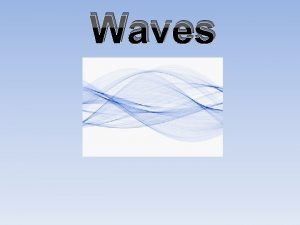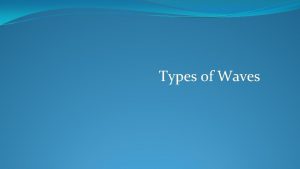Types of Waves Part 4 Types of Waves











- Slides: 11

Types of Waves Part 4

Types of Waves • Imagine a cello being played, the strings vibrate to produce a sound. The wave patterns on the string themselves are what we call stationary waves (standing waves) • The waves in the air that carry the sound propagate through the air, these are called progressive waves

A slinky shows a transverse wave. Once it reaches the fixed end it will reflect back. If you sent another pulse before the first pulse got back the two pulses will interfere and cause a stationary wave.

A stationary wave is the result of interference between two waves of equal frequency and amplitude, traveling along the same line with the same speed, but in opposite direction • As the cello string is plucked, and allowed to vibrate it will go through different frequencies. This is known as the resonance effect. • A simple vibration of the string, this is called the first harmonic, or fundamental mode of vibration • The ends have no vibration, these are the node. • The center has maximum vibration, called the antinode

The second mode of the vibrating string, called the first overtone, or the second harmonic.

• The third mode of the vibrating screen, also called the second overtone, or the third harmonic


Air in closed tube

Example 1

Example 2

Classwork
 Lowest point of a wave
Lowest point of a wave Sound waves are longitudinal waves true or false
Sound waves are longitudinal waves true or false Mechanical and electromagnetic waves similarities
Mechanical and electromagnetic waves similarities Difference between electromagnetic and mechanical waves
Difference between electromagnetic and mechanical waves Characteristics of a longitudinal wave
Characteristics of a longitudinal wave Sound is a longitudinal wave
Sound is a longitudinal wave Short wave vs long wave radiation
Short wave vs long wave radiation Mechanical waves and electromagnetic waves similarities
Mechanical waves and electromagnetic waves similarities Mechanical vs electromagnetic waves
Mechanical vs electromagnetic waves Mechanical waves and electromagnetic waves similarities
Mechanical waves and electromagnetic waves similarities Surface waves and body waves
Surface waves and body waves Seismic waves are mechanical waves
Seismic waves are mechanical waves





















